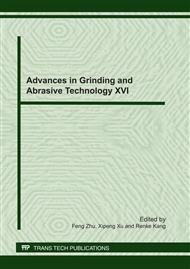p.386
p.391
p.396
p.402
p.407
p.413
p.419
p.423
p.429
Study of the on-Line Testing Method for the Abrasive Belt Follow-up Grinding of the Crankshaft Crankpin
Abstract:
In order to get the crankshaft crankpin’s surface shape errors and geometric dimension in real time, this paper presented an on-line follow-up tracing measurement method for measuring the roundness error and diameters of the crankshaft crankpin same time according with the characteristics of the crankshaft abrasive belt follow-up grinding process. After analyzing the movement control model of the follow-up tracing system, we obtained the constraint conditions which can fill the uniform sampling requirements of the sensor group. On this basis, we put forward the three-sensor follow-up tracing principle to separate the crankpin’s roundness error and systematic error from the actual measurement data. According to the principle of DFT, the fundamental equations of the three-sensor tracing principle for the roundness error separation were deduced in details. It is testified by experiments that: the roundness error source can be obtained by analyzing the original data, then we can compensate the errors through the feedback control system, so as to achieve the objective of improving the crankshaft crankpin’s roundness and the processing precision of the crankshaft crankpin.
Info:
Periodical:
Pages:
407-412
Citation:
Online since:
July 2011
Price:
Сopyright:
© 2011 Trans Tech Publications Ltd. All Rights Reserved
Share:
Citation:


